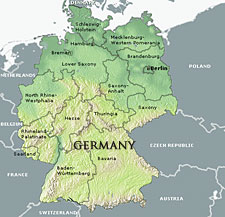For the last couple of years, auto analysts and others have focused most of their attention on Detroit, the home of General Motors and Ford, two iconic American car companies that have been losing money, shedding workers by the tens of thousands and looking for strategies that will help them back on track. But what has been going on in Wolfsburg, the headquarters of Volkswagen, a quintessential German automaker, and in Stuttgart, headquarters of DaimlerChrysler, a German-American hybrid?
Quite a bit, actually. VW’s relationship with Porsche, a much smaller company than VW, has gotten cozier, now that Porsche has upped its ownership stake in VW. But the major story in Germany’s auto sector is the still-unknown fate of yet a third iconic U.S. car brand, Chrysler. Acquired by DaimlerBenz in a much-ballyhooed deal nine years ago under Jürgen Schrempp, Daimler’s former chief executive, Chrysler is being eyed for purchase by several private equity firms. It took a while, but Daimler finally reached the conclusion that the marriage was not working and decided that jettisoning its unwanted partner was one option that had to be put on the table.
Yet overall, the German auto industry is considerably healthier than its U.S. counterpart, despite the fact that VW is embroiled in an ethics scandal, and DaimlerChrysler — while it has made progress in addressing serious quality problems with its Mercedes Benz cars in the last couple of years — is not entirely out of the woods yet. And all German carmakers, especially the large-engine, gas-guzzling, luxury brands, will have to adjust to newfound concerns over global warming and the resulting emissions restrictions being imposed by the EU.
But the industry has a lot going for it, too. “The main strength, I’d still say, is brand image,” says Matthias Holweg, director of the Center for Competitiveness and Innovation at Cambridge University’s Judge Business School and a researcher with the International Motor Vehicle Program. “Germany still is able to produce cars difficult to get elsewhere. If you drive a Mercedes, you still make a strong statement…. German cars are generally based on outstanding design. I’d call them strong identity products. Being German myself, I do find many other cars utterly boring.”
Looking under the Hood at DaimlerChrysler
What’s not boring is the swirl of activity that has recently engulfed DaimlerChrysler. According to The Wall Street Journal and the Financial Times, DaimlerChrysler expects to have preliminary offers to buy its Chrysler unit by March 30. The three bidders reportedly would include Cerberus Capital Management, a New York private equity firm; a pair of private equity firms working together on a bid, Blackstone Group and Centerbridge Partners, both based in New York; and Magna International, a Canadian maker of auto parts. The FT also reported in its March 24-25 weekend edition that Magna had teamed up with Ripplewood Holdings, another New York private equity firm, and that there was a possibility that GM could eventually join one of the private equity bidders. DaimlerChrysler shares on March 23 rose 6.1% to close at $82.36, a 52-week high.
Experts at Wharton and elsewhere say the Daimler-Chrysler merger, if not quite doomed from the start, got off to a rocky beginning. And although there were some positive developments in the years that followed, the combined company never really managed to move into high gear.
Although the deal had been billed as a merger of equals at the time it closed in 1998, subsequent press reports showed that the strong-willed Schrempp viewed the transaction as an acquisition and that Daimler would hold sway over its Motor City counterpart.
“There was a big negative reaction against that in Chrysler’s executive ranks,” says John Paul MacDuffie, a Wharton management professor and co-director of the International Motor Vehicle Program. “A number of Chrysler’s most talented executives — the people responsible for making Chrysler the best managed of the Big Three U.S. carmakers up to that point — left the company.”
Another challenge that the merged company never quite got a handle on was how to reconcile the conflicting images of a European luxury brand and an American brand with a much broader product line that included stodgy minivans and other non-luxury models.
The executives at DaimlerChrysler “had such a concern about the big difference in the brands of Mercedes and Chrysler that they seemed resolved to manage them as separately as possible,” MacDuffie notes. “But a lot of the reason for a merger in this industry is to gain the synergies of larger scale — joint purchasing, joint product development and the like. It took the company years to figure out how to do that. Some Daimler components have shown up in Chrysler products, and that’s been viewed as a real positive. But DaimlerChrysler was slow in doing that.”
Chrysler was beset by the same difficulties that had been afflicting Ford and GM — high labor, benefits and pensions costs, plus lackluster sales. “The business model of the U.S. Big Three is clearly struggling right now,” says MacDuffie. “Chrysler is as affected by that as GM and Ford are. So some of the problems at DaimlerChrysler had nothing to do with the way Daimler has managed Chrysler. The decision by Chrysler to stay in big trucks and SUVs was made years ago. But Daimler allowed the decision-making pattern that has gotten all three big makers in trouble.”
Ulrich Jürgens, a professor at the Berlin Social Science Research Center, says DaimlerChrysler decided to entertain offers for Chrysler because the parent company “didn’t see how to get out of the crisis at Chrysler — what to do and how much to spend on Chrysler.”
Indeed, the biggest mistake may have been Schrempp’s grandiose plan to seek a merger partner at all, according to Jürgens and MacDuffie. They say that DaimlerBenz made a strategic misstep in deciding that, to compete internationally, it needed to be bigger.
“The whole idea that you have got be a big company to survive, which was held widely in the late 1990s, has been discredited,” explains MacDuffie. “The smaller companies — like BMW — that have stayed small have done extremely well. It doesn’t mean there aren’t advantages to scale, but the idea that you survive only if you rush to buy a company to meet a certain minimal size is discredited. A lot of German shareholders have grown impatient. They have watched [financial] losses mount up and even declines in performance in the Mercedes unit, like recalls and product problems. That’s been a distraction for management.”
MacDuffie recalls how BMW had a similar problem with its ill-fated acquisition of Britain’s MG Rover in the 1990s. Before BMW sold Rover to a group of investors, it made one key move: It kept the Mini. “What BMW took away from that unhappy period was the Mini brand from Rover,” MacDuffie explains. “BMW added this one product [and made some changes to it to make it more appealing to customers], which they have done fantastically with. The closest analogy with Chrysler would be if Daimler had kept the Jeep model and ‘Mercedes-ized’ it in some way. But that’s not what Daimler did.”
Jürgens agrees that DaimlerChrysler might actually find it liberating to shed Chrysler. “They would face a new situation if they become smaller,” he says. “But they would have BMW as a role model.”
If DaimlerChrysler does decide to sell Chrysler, the buyer might break upthe venerable company, according to Holweg, the Cambridge researcher. “This is rather speculative, but my guess would be that a private equity firm would sell — and maybe lease back — the land and other flexible assets, shrink the business, and close all subsidiaries and plants that are no longer needed. I would argue that Jeep is the crown jewel, and I could see that being sold to a third party, such as Magna Steyr [an Austrian firm that assembles vehicles for auto companies under contractual arrangements] or even a large supplier. The Chrysler brand and production assets, of course, would also be of interest to Chinese companies.”
Whether Chrysler and its Dodge unit would survive under a new owner is “questionable,” Holweg adds. “I think neither has a great brand image. And, if kept within DaimlerChrysler, then I think the game is further downsizing as well.” One option in this regard would be to close or sell the car operations, and focus on trucks (the Freightliner), light trucks (Dodge) and 4x4s (Jeep) only. Holweg says this step would be “radical, but probably sensible.”
Despite the rocky road experienced by DaimlerChrysler, there was a time when observers thought that the merger might actually work.
“A couple of years ago, I and others thought Chrysler might escape some of the woes of GM and Ford because after that difficult start they seemed to figure out how to get some synergies out of the combined company,” MacDuffie says. “A decision to finally get some Daimler engineering into Chrysler products seemed to be working. Chrysler had some exciting new products that were generating all the good things a hip product does, both buzz and profits. I think any close look even then at their product portfolio would make them vulnerable to a big increase in energy prices, which could happen any time. That was the event that really highlighted some of the problems at Chrysler and its commonalities with GM and Ford and maybe dwarfed some of the accomplishments that were beginning to emerge after struggling to manage the combined company.”
Porsche Makes its Move
While DaimlerChrysler is looking to slim down, Porsche, a world-famous brand but still a niche player in the global auto industry, has made a move to increase its influence at VW, Europe’s largest car company in terms of volume. Porsche disclosed over the weekend of March 24 that it had exercised an option to increase its ownership position in VW from 27.3% to 30.9%.
Under German law, a company that takes an ownership stake of 30% or more in another firm is obligated to make a formal takeover offer for that firm. Porsche said it would adhere to the law and make such an offer for VW. But Porsche said it would offer only the legal minimum of $134 per share, much less than the price of $156 per share price at which VW closed on March 23. That makes the offer more symbolic than a true takeover attempt, according to Jürgens.
Porsche has several reasons to want to increase its ownership position in VW, Jürgens adds. For one thing, the move allows Porsche to increase its influence within VW, a company with which it has long had both business and personal ties. Ferdinand Piëch, a grandson of the founder of Porsche, sits on the supervisory boards of both companies (the equivalent of a U.S. board of directors) and is chairman of the board of VW. Piëch also once served as chief executive of VW. “The whole Piëch family has … shares in Porsche and Volkswagen,” he says. Indeed, Piëch and his family own all of Porsche’s voting shares.
Another motive is to protect VW from a potential hostile takeover, even though Jürgens sees this possibility as remote. In an interview with the German newspaper Bild, Wendelin Wiedeking, Porsche’s chief executive, said his company was concerned that hedge funds, which he did not identify, might try to grab control of VW and break up the company. Hedge funds are not viewed kindly in Germany, and the ownership of VW is a sensitive issue. Indeed, American investors would find its capital structure unusual: the German state of Lower Saxony owns 20.3% of VW.
Government ownership of a chunk of VW is testimony to the government’s deeply held concern for the welfare of workers. Some politicians would like to see Lower Saxony sell all or part of its stake in VW, a move that could open the door to buyers whose interests in VW may run contrary to that of the Porsche family, according to Jürgens. Hence, there is an interest in keeping things as they are. By boosting its stake to 30.9%, Porsche is telling everyone that it wants to be the dominant player in VW.
“There are considerations to keep this balance,” Jürgens says. “Otherwise, Lower Saxony could opt to get out and sell its shares, which would not be very good for the share price and for Porsche. So Porsche probably wants to keep the balance so that nobody rocks the boat, so to speak. So they send a signal [with] 31% ownership.”
Jürgens says Porsche’s move also indirectly strengthens Germany’s so-called “Volkswagen law,” whose conditions make it almost impossible for VW to be acquired in a hostile takeover. Jürgens notes that many observers feel it is just a matter of time before a European Union judge rules that the “Volkswagen law” is illegal under EU statutes. “In the past there was a lot of fear that institutional investors could take over Volkswagen,” he says. “They have bid up shares in the past and it would have been easy to take over VW.” With Porsche’s increased ownership stake, “the situation is much more stable.”
A third reason for Porsche’s desire to boost its influence within VW is to underscore Piëch’s desire to continue to develop vehicles with VW and to encourage VW to increase its presence on the global automotive stage. “Porsche would consolidate its cooperation with Volkswagen in terms of putting together certain cars,” according to Jürgens. He notes that the components of the Porsche Cayenne, a sport utility vehicle, are built at a VW plant in Bratislava, the capital of Slovakia, and that Porsche has a similar cooperative agreement with a VW truck plant in Hanover, Germany.
“The [current] operational integration would be consolidated by Porsche with its purchase of the additional VW shares,” Jürgens notes. “Also, if Porsche wants to go into other car lines, they would probably need the developmental potential from Volkswagen. I think there are a lot of plans to use the VW capabilities and resources to develop Porsche.”
Meanwhile, Holweg says Piëch for quite some time has been working to consolidate his power within VW.
Piëch orchestrated the ouster of Bernd Pischetsrieder, VW’s chief executive at the time, in 2006 with the aim of moving VW in a new direction, Holweg notes.
“Pischetsrieder outsmarted Piëch when VW made a bid for Rolls Royce in 1998; that was the start of the battle. Now, Piëch has come back; he couldn’t let go. He has put Martin Winterkorn in charge at VW [as chief executive].”
The increased ownership of VW is “largely a personal quest of the Piëch-Porsche clan,” driven by Piëch, Holweg notes, adding that it is “surprising that the other stakeholders are granting him the freedom to exert this level of control.”
But Holweg sees little practical consequence in Porsche’s decision to increase its stake in VW. “What is the significance of this? None, really. Apart from the SUV joint venture, there is little synergy or overlap between the two companies…. There is too little commonality. So it might become a ‘financial’ marriage, but hardly an ‘operational’ one.”
Nonetheless, is it likely that Porsche and VW will merge? “Yes,” responds Holweg, “if Piëch gets his way.”



